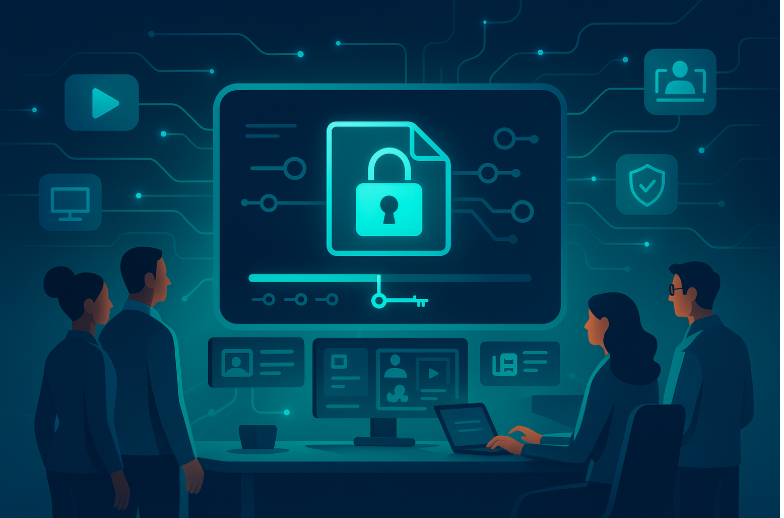
Introduction: Why Video Encryption Is a Must in 2025
With online video now powering industries from education to entertainment, content protection is no longer just a technical add-on—it’s a strategic requirement. Whether you run a paid course platform, an OTT service, or a corporate LMS, your video content represents intellectual property and real revenue.
Yet, every day, creators and companies lose income and control to piracy. The solution? Strong, scalable video encryption backed by proven access controls.
In this post, we’ll explore what video encryption really means in 2025, how it works, what makes it secure (or not), and how services like VdoCipher make it simple to implement for any size business.
What Is Video Encryption?
Video encryption refers to the process of encoding video data so that it cannot be viewed or used by unauthorized users. The goal is simple: only those with valid credentials and playback rights can decrypt and watch the video.
But not all encryption is created equal.
Basic AES encryption might protect your files in transit—but without proper key management and playback control, those files can still be downloaded or redistributed.
Modern video encryption systems combine:
- Strong AES-128 or AES-256 encryption of the video content
- Delivery via secure, adaptive streaming protocols like HLS or DASH
- Dynamic license generation for access validation
- Hardware-level playback restrictions via DRM
How Secure Video Encryption Works
A robust video encryption setup typically includes:
- Video Packaging: Your raw video is encoded into a streaming-friendly format like HLS or MPEG-DASH.
- Encryption: Each segment of the video is encrypted using a unique key.
- License Server: When a viewer hits “Play,” a secure token is sent to a server that checks their access and issues a decryption key.
- Secure Playback: Only authorized players—like those in your app or website—can decrypt and play the stream.
This system ensures:
- No direct access to the video file or URL
- Playback only in approved environments
- Ability to revoke access, expire sessions, or restrict playback by IP or device
This is the model used by global content giants—and by VdoCipher for smaller platforms who need the same protection without the tech overhead.
Video Encryption vs. DRM: What’s the Difference?
Many people use video encryption and DRM interchangeably—but they’re not the same.
- Encryption protects the video file itself from being accessed without the correct key.
- DRM (Digital Rights Management) controls how and where that key can be used—adding rules like playback limits, device restrictions, offline download expiration, and screen recording prevention.
Platforms like VdoCipher combine both—AES encryption for data security and DRM for rights enforcement. This is why major OTT platforms rely on systems like Widevine DRM (Google) and (Apple) to stream movies and TV shows securely.
Use Cases for Encrypted Video Delivery
Encryption is not just for Hollywood blockbusters. Here’s where it matters most:
- E-learning platforms: Prevent students from downloading and sharing course materials
- Fitness or coaching apps: Stop piracy of paid training videos
- Corporate LMSs: Protect internal communication and compliance training
- Media publishers: Deliver subscription-only content
- Healthcare or legal firms: Share videos under strict privacy regulations
If you’re using video hosting to deliver content that has any value—monetary, reputational, or legal—then encryption is absolutely necessary.
Widevine & FairPlay: Industry Standards for Secure Encryption
Google’s Widevine DRM and Apple’s FairPlay DRM are two of the most widely adopted standards for secure, encrypted video delivery.
Widevine DRM
- Used in Chrome, Android, Smart TVs, and desktop apps
- Supports HD/UHD playback with screen recording prevention
- Offers three levels of device security (L1, L2, L3)
- Ideal for Android apps and browser-based playback
FairPlay DRM
- Required for secure playback on iPhones, iPads, and Safari
- Blocks screen recording in most Apple environments
- Enables encrypted offline downloads
- Perfect for Apple-focused audiences or iOS-first apps
By using a platform like VdoCipher that supports both, you get seamless protection across all devices—without building the complex backend yourself.
Offline Video Encryption
One major challenge is allowing offline playback without losing control of your content. Downloaded videos can easily be shared—unless they’re encrypted and tied to a single device.
VdoCipher’s solution:
- Downloads are encrypted on the device, not saved as open files
- Playback only happens inside the app using decryption keys and session tokens
- Expiry settings ensure content auto-deletes or revalidates
- Offline playback still obeys DRM rules like screen capture prevention
This allows creators to offer flexibility to users in poor connectivity regions—without compromising security.
Secure Video Embedding with Encryption
Embedding a video on your website doesn’t mean you have to give up control. With tokenized, encrypted embeds, you can:
- Limit playback to your own domain
- Use expiring URLs and session tokens
- Tie playback to individual users or login sessions
- Prevent iframe hijacking or download attempts
Platforms like VdoCipher offer secure with easy-to-use embed codes that work across web and mobile platforms.
Bonus: Combine Encryption with Analytics & Monetization
Strong video encryption is just the first step. For full control, pair it with:
- Viewer analytics: Who’s watching, where, and how long
- Geo/IP restrictions: Block access from unauthorized regions
- Dynamic watermarking: Show user info over the video to discourage piracy
- Token-based access control: Limit concurrent streams or device usage
- Monetization options: Sell subscriptions, single videos, or bundles securely
All of these features are available natively with VdoCipher—giving you enterprise-grade protection in a creator-friendly platform.
Final Thoughts
In 2025, putting your video online without encryption is like publishing a book without a cover—anyone can take it, copy it, and share it. Whether you’re teaching, entertaining, or informing, video encryption protects your business, your IP, and your reputation.
Solutions like Widevine DRM and FairPlay DRM go far beyond basic security—offering a full suite of tools to prevent leaks, control access, and secure offline use.
Platforms like VdoCipher bring this power to your fingertips—handling the encryption, licensing, secure playback, and video hosting in one place. Whether you’re a solo creator or an EdTech startup, that kind of security is what sets you apart.



